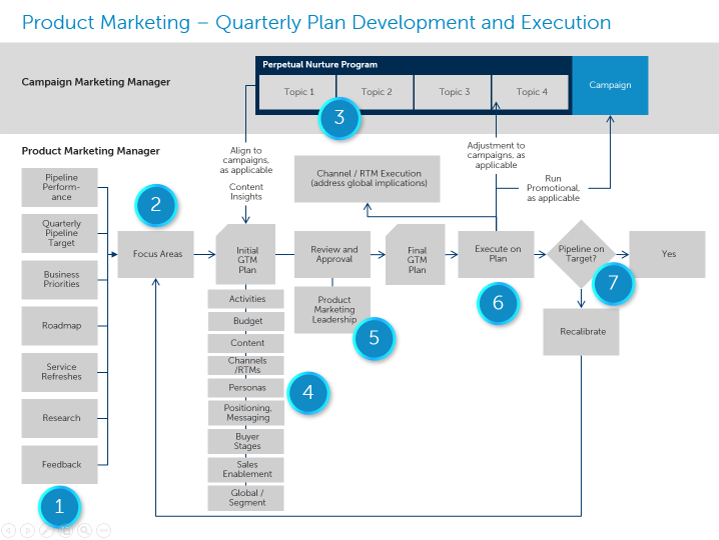Creating a Product Marketing Plan
How Do You Create Your Product Marketing Plan?
I’ve seen lots of different ways that organizations go about creating a Product Marketing plan as well as ways that Product Marketers and teams don’t go about creating a plan at all. In the end, I have yet to see a consistently applied process and end-result in terms of planning for Product Marketing. That’s not to say that there aren’t some really good plans out there because they are. However, I do believe that a lot of Product Marketers simply aren’t sure how best to go about creating their plan. So, I thought I would share something I put together that should help those wondering about how to not only get to a plan but ensure that the right elements are feeding into the creation and end result.
Feel free to leverage what I have here for your own processes and planning efforts. You may want to modify based on your own environment, organization, team and other needs. One important point – creating a plan isn’t something to just be done out of the blue in the next week. You should be thinking about your next plan a little each day as it should take some time to really come up with what you plan on executing on in the next quarter. There are a lot of insights that should drive your plan and that isn’t something that is done by a couple days reading analyst and other reports.
I’ll explain the numbers below.

Stage 1
Stage 1 is all about pulling in research, feedback and other insights from across the business–this includes priorities and performance metrics from the business groups you support, roadmap and research from Product Management, feedback from Sales (see my post on Gaining Real Insights from Sales), performance data on campaigns and other marketing activities, insights from win/loss programs (see my post on The Power of Win/Loss Analysis), as well as corporate-wide priorities from leadership. This step also includes a lot of research on the market, competitive insights, trending topical areas, etc.
Regarding metrics – and I’ll talk more about this in other posts – you should always have a bead on the performance of your portfolio. You should have visibility into revenue targets and YTD revenue figures, sales targets and YTD sales figures, average deal sizes, opportunity pipeline and close rates, etc. I can’t stress this knowledge enough as it is, in my opinion, one key area that distinguishes a great product marketer from a good one.
Stage 2
Stage 2 really entails honing in on what you think the top 3-5 focus areas are for the quarter. Sometimes a focus area can be a major product launch that you know will take precedent or be a high priority. Sometimes a focus is performing a major campaign in support of your all or part of your portfolio. Sometimes a focus area can be an update to sales enablement materials or a refresh of major positioning/messaging related to your portfolio. Sometimes a focus area may be changing or expanding web navigation to better align to what your target audience is looking for. Sometimes a focus area might be to perform major persona research. You get the idea.
The key thing here is that after all of your Stage 1 efforts and insights, a handful of areas should jump out in terms of priority. I suggested earlier to have 3-5 and you should. However, be prepared to hone that further to your top 3 most impactful and achievable areas.
Stage 3
Stage 3 is really about tying off with your Demand Gen brethren and reviewing campaign metrics. A sharp Demand Gen person will have good insights on campaign topics as well as new content ideas for the future. You should of course have them also. Collaborate with them on what campaigns and possible major content pieces might be compelling to execute that can support your overall portfolio objectives.
Stage 4
Stage 4 involves putting together your initial plan. You should be considering all of the factors listed in the image above. That’s not to say that you have to address all of those areas through your plan. But each of your focus areas needs to at least consider each of them.
You’ll see “RTMs” listed. This is your routes-to-market for your product and includes everything from marketing channels to sales teams to partners, etc. You need to consider where most of your business comes from and how you are providing cpverage as it pertains to your focus areas. This may seem potentially exhaustive to think about and it can be. However, what you actually put in your plan and commit to is likely to be significantly less as you have to keep in mind what is actually achievable by you and by leveraging or collaborating with other resources in the marketing organization, with Product Management, with support teams if necessary and with Sales.
Stage 5
Stage 5 is really about making sure your leadership is bought off on the thinking. I’d recommend bringing your plan to your leadership earlier to get their insights so as not to have any surprises. The good news is that any good Product Marketing leader should already have an idea as to what you may need to focus on and can provide early insights.
Stage 6
Execution. Execution. Execution.
One cautionary note. If your plan is rife with vague tactics or appears to take on a tremendous amount of deliverables, execution will prove difficult. And your leader won’t be happy. Keep your plan focused, concise, achievable but clearly impactful. As a Product Marketing leader, I don’t like to review plans and your progress to plan that end up being a complete waste of time because the plan wasn’t clear as to what you would deliver on and when or you seemed to have committed to a lot but not delivered on it. You could argue that your leader should be acting as a filter and sanity check on your plan and that would be absolutely right. However, make it easy for your leader to do this because you put the right thought into how you devised your plan and came up with what you feel is achievable and impactful.
Stage 7
Stage 7 is about checking the metrics over time to see how your plan is performing/has performed. Meaningful metrics that a Product Marketing Manager can operate from aren’t always easy. The fact is that a lot of what we do isn’t felt until later and it may be hard to know what the impact or performance of your overall plan was. After all, other things happening in the business may contribute to the results (for example, Sales leadership implements a SPIFF to incentivize deals). However, you can look at individual activities for metrics information and make some inferences as to the impact. Put aside that notion that metrics are not worthwhile because of the reasons I stated above and operate with a notion that any and all metrics have potential value in guiding your future activities in support of your portfolio. Over time, you will figure out which metrics really do matter and what you can do to alter them.
Conclusion
There is no one way to come up with your Product Marketing plan. However, the template above gives you a sense of what Product Marketers and their leaders can focus in on as inputs to the planning process.
As a Product Marketer, David has successfully launched products, services, solutions and platforms across a number of disciplines in the technology industry. David’s passion for Product Marketing and his eye for seeing how Product Marketing can lead to even stronger business outcomes led him to bring his expertise and knowledge to Shoot the Curl Marketing.



